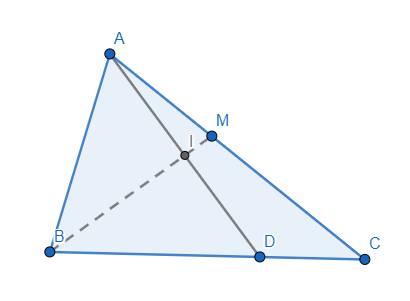Hãy nhập câu hỏi của bạn vào đây, nếu là tài khoản VIP, bạn sẽ được ưu tiên trả lời.

\(\overrightarrow{AM}=\overrightarrow{AB}+\overrightarrow{BM}=\overrightarrow{AB}+\dfrac{2}{5}\overrightarrow{BC}\)

Xét ΔBAD có BI là đường trung tuyến
nên \(\overrightarrow{BI}=\dfrac{1}{2}\left(\overrightarrow{BA}+\overrightarrow{BD}\right)\)
=>\(\overrightarrow{BI}=\dfrac{1}{2}\left(\overrightarrow{BA}+\dfrac{2}{3}\overrightarrow{BC}\right)\)
\(=\dfrac{1}{2}\left(\overrightarrow{BA}+\dfrac{2}{3}\overrightarrow{BA}+\dfrac{2}{3}\overrightarrow{AC}\right)\)
\(=\dfrac{1}{2}\left(\dfrac{5}{3}\overrightarrow{BA}+\dfrac{2}{3}\overrightarrow{AC}\right)\)
\(=\dfrac{1}{2}\cdot\dfrac{1}{3}\left(5\overrightarrow{BA}+2\overrightarrow{AC}\right)=\dfrac{1}{6}\left(5\overrightarrow{BA}+2\overrightarrow{AC}\right)=\dfrac{5}{6}\left(\overrightarrow{BA}+\dfrac{2}{5}\overrightarrow{AC}\right)\)
\(\overrightarrow{BM}=\overrightarrow{BA}+\overrightarrow{AM}\)
\(=\overrightarrow{BA}+\dfrac{2}{5}\overrightarrow{AC}\)
=>\(\overrightarrow{BI}=\dfrac{5}{6}\cdot\overrightarrow{BM}\)
=>B,I,M thẳng hàng

Cách 1: Dùng định lý Menelaus đảo:

Từ đề bài, ta có \(\dfrac{BD}{BC}=\dfrac{2}{3}\), \(\dfrac{MC}{MA}=\dfrac{3}{2}\), \(\dfrac{IA}{ID}=1\)
\(\Rightarrow\dfrac{BD}{BC}.\dfrac{MC}{MA}.\dfrac{IA}{ID}=1\)
Theo định lý Menelaus đảo, suy ra B, I, M thẳng hàng.
Cách 2: Dùng vector
Ta có \(\overrightarrow{BI}=\dfrac{1}{2}\left(\overrightarrow{BA}+\overrightarrow{BD}\right)\)
\(=\dfrac{1}{2}\overrightarrow{BA}+\dfrac{1}{2}.\dfrac{2}{3}\overrightarrow{BC}\)
\(=\dfrac{1}{2}\overrightarrow{BA}+\dfrac{1}{3}\overrightarrow{BC}\)
\(=\dfrac{1}{6}\left(3\overrightarrow{BA}+2\overrightarrow{BC}\right)\)
Lại có \(\overrightarrow{BM}=\dfrac{MC}{AC}\overrightarrow{BA}+\dfrac{MA}{AC}\overrightarrow{BC}\)
\(=\dfrac{3}{5}\overrightarrow{BA}+\dfrac{2}{5}\overrightarrow{BC}\)
\(=\dfrac{1}{5}\left(3\overrightarrow{BA}+2\overrightarrow{BC}\right)\)
\(=\dfrac{6}{5}.\dfrac{1}{6}\left(3\overrightarrow{BA}+2\overrightarrow{BC}\right)\)
\(=\dfrac{6}{5}\overrightarrow{BI}\)
Vậy \(\overrightarrow{BM}=\dfrac{6}{5}\overrightarrow{BI}\), suy ra B, I, M thẳng hàng.

a: \(\overrightarrow{CN}=\dfrac{1}{2}\overrightarrow{CA}+\dfrac{1}{2}\overrightarrow{CB}\)
\(=\dfrac{1}{2}\overrightarrow{CB}+\dfrac{1}{2}\overrightarrow{BA}+\dfrac{1}{2}\overrightarrow{CB}\)
\(=\dfrac{1}{2}\overrightarrow{u}-\overrightarrow{v}\)

1.
Gọi M là trung điểm BC thì theo tính chất trọng tâm: \(\overrightarrow{AG}=\dfrac{2}{3}\overrightarrow{AM}=\dfrac{2}{3}\left(\dfrac{1}{2}\overrightarrow{AB}+\dfrac{1}{2}\overrightarrow{AC}\right)\)
\(\Rightarrow\overrightarrow{AG}=\dfrac{1}{3}\overrightarrow{AB}+\dfrac{1}{3}\overrightarrow{AC}\Rightarrow x+y=\dfrac{2}{3}\)
2.
\(CH=\dfrac{1}{2}BC=\dfrac{a}{2}\)
\(T=\left|\text{ }\overrightarrow{CA}-\overrightarrow{HC}\right|=\left|\overrightarrow{CA}+\overrightarrow{CH}\right|\)
\(\Rightarrow T^2=CA^2+CH^2+2\overrightarrow{CA}.\overrightarrow{CH}=a^2+\left(\dfrac{a}{2}\right)^2+2.a.\dfrac{a}{2}.cos60^0=\dfrac{7a^2}{4}\)
\(\Rightarrow T=\dfrac{a\sqrt{7}}{2}\)
3.
\(10< x< 100\Rightarrow10< 3k< 100\)
\(\Rightarrow\dfrac{10}{3}< k< \dfrac{100}{3}\Rightarrow4\le k\le33\)
\(\Rightarrow\sum x=3\left(4+5+...+33\right)=1665\)